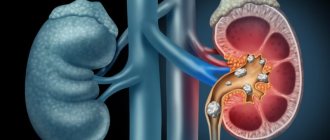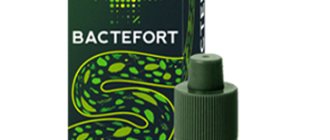The most dangerous reason
Meningococcus in the blood causes destruction of the walls of blood vessels. Subcutaneous hemorrhages appear, small at first, then the spots increase. If you apply the bottom of a glass or other transparent object to the meningitis rash and press, you can see through it that the rash has not changed color or disappeared. All other types of rash usually disappear when pressed.
Checking rashes to determine meningitis in children
Other signs of meningitis and infection spreading to the blood:
- headache, especially in the back of the head;
- snot, but not very strong;
- vomiting due to damage to food nerve centers;
- temperature 38-40℃;
- photophobia;
- a loud cry, convulsions, and arching of the body are possible.
How to treat meningitis? Only in a hospital, first in intensive care. There are strong antibiotics that, when administered in a timely manner, quickly defeat meningitis. Every ambulance team should have such drugs with them. It is important to explain the situation in advance by phone that you suspect a meningococcal infection, so that the doctor immediately takes this drug with him.
Is the rash different, does it disappear with pressure? No headache? Is your child's temperature very high? And there was only one vomiting, after which the child felt better? You can relax a little. But remember that a rash or vomiting in children with a high fever or even without a fever, but feeling unwell, is already an indication to call a pediatrician, especially under 6 years of age.
And when these three signs are combined, it is all the more necessary to call a doctor, and during the call talk about the symptoms. And while the doctor is on his way, try to figure out why the child might have developed such a combination of symptoms. To do this you need to remember:
- what your baby has eaten in the last 24 hours;
- where have you been;
- what medications did you take?
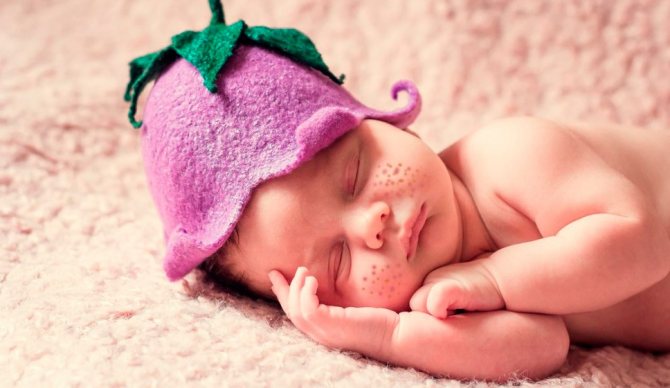
Treatment
If vomiting and nausea during chickenpox do not stop after a day, then you should consult a doctor, as sometimes this may indicate damage to brain cells by the Zoster virus. In this case, treatment is carried out in a hospital.
If negative symptoms from the gastrointestinal tract are associated with a special reaction of the body to intoxication with the herpes virus, then the following methods can be used as treatment:
- First of all, symptomatic therapy is indicated. Taking sorbents will help improve the condition and protect the intestines from toxins.
- If a secondary bacterial infection is present, antibiotic therapy is indicated as treatment.
- Vomiting and diarrhea can be caused by some medications that the patient took for treatment, so it is necessary to review the list again and consult a doctor.
- The specialist may prescribe special antiemetic drugs.
- If diarrhea and nausea occur due to disruption of the microflora by taking antibiotics, then probiotics are indicated, which will restore the natural intestinal microflora and relieve the patient from nausea and diarrhea.
Important! If the patient's condition worsens sharply due to vomiting and diarrhea, urgent hospitalization is needed.
In any case, with diarrhea and vomiting, it is very important to restore the water-salt balance of the body, therefore, in addition to drug treatment, it is necessary to drink more fluid. Compotes, teas, and fresh juices are suitable for drinking heavily. The drink should be warm so that it is absorbed from the intestinal tract as quickly as possible. Regidron restores the water-salt balance very well.
Why do each of the symptoms occur separately?
Vomiting occurs due to:
- spasms of the stomach walls, which can be caused by chemical or food poisoning;
- stimulation of the digestive centers in the brain during severe stress, head injury, intracerebral infection or tumor.
Temperature is a manifestation of:
- infections or inflammations;
- overheating;
- stress.
The rash may appear as a result of:
- skin irritation from insect or tick bites, household chemicals, sweat and secretions of the sebaceous glands;
- reactions to heat or cold;
- an allergic reaction, which in typical cases occurs without fever;
- infectious diseases: measles, rubella, scarlet fever, chicken pox, roseola.
If a child is affected by a combination of any of the causes of each of the three symptoms, then this can give the following picture: at the same time a rash, fever and vomiting. But there are also typical cases.

Rash and vomiting in a child
The appearance of a rash on a child’s body can be caused by many different reasons. Among them are viral infections, as well as some conditions that may well become quite dangerous for human health and his future life. These factors include the following conditions:
- infectious diseases caused by exposure to parasites on humans;
- various stages of development of allergic reactions;
- diseases of blood vessels and organs of the human circulatory system;
- improper care of your child's skin.
With infectious lesions of the human skin, a combination of skin rashes and vomiting is quite often observed. In addition, often in such cases there is an increase in the patient’s temperature and exacerbation of diarrhea. Very often, the disease does not appear immediately, but a day or two days after the infection enters the human body.
There are quite a few different options for the appearance of a rash on a child’s skin, combined with vomiting. It is not always possible to accurately determine the cause of this phenomenon, so in such situations you should visit a doctor. The delicate skin of a child turns out to be quite susceptible to such manifestations, so the rash can be found both on the baby’s face and in other parts of his body.
Causes: diseases and their combinations
None of these options are as dangerous as the meningococcal infection we have already described.
But only if medical care is provided in a timely manner. Possible causes of rash, fever and vomiting in a child
| Cause | What kind of rash? | What temperature? |
| Allergy + food poisoning | Small, disappears when pressed. There may be red spots. | -39℃ and above |
| Infection+food poisoning | Characteristic of measles, chickenpox, rubella, scarlet fever. | 38-40℃ |
| Viral arthritis | Bumps on the skin. Redness and pain in the joint area. | -39℃ |
What is an allergy rash?
The nature of the allergic reaction can be different, depending on the individual characteristics of the body, the presence or absence of a tendency to allergic rashes, and the type of toxic substance. The rash after intoxication manifests itself as follows:
- hives (most common after food poisoning);
- spots of red or pink color;
- bubbles filled with clear liquid;
- formation of crusts and pockets of erosion on the skin.
The rash does not occur on its own; it is always accompanied by a number of unpleasant symptoms that cause a person to feel discomfort. With urticaria, a person experiences itching and a burning sensation. In addition, the rash can appear on any part of the body.
If the factor that provoked the body’s negative reaction is not eliminated in time, the symptomatic picture will become more complicated. For example, often after intoxication a rash of pink or red spots is observed, while the skin itches severely and peeling begins. When bubbles are formed, filled with a transparent liquid, they burst after a few days, forming erosive foci with further covering with a hard crust.
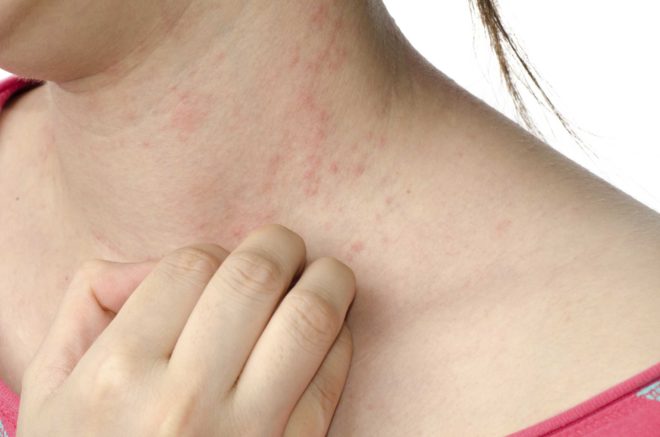
If a person does not know what caused the body’s negative reaction, it is necessary to undergo tests to identify the allergen. If the provoking factor, which often turns out to be a certain food product, is not identified, the symptoms will appear more frequently, more intensely each time and have a clinical picture of food poisoning.
It is not recommended to treat the rash on your own. Therapy is selected individually. If the allergy is caused by dysbacteriosis, treatment is aimed at restoring the normal microflora of the digestive system with the complete removal from the body of toxic products that could remain after intoxication.
If a person has consumed a product to which he has an individual intolerance, treatment consists, first of all, of removing the provoking factor. To relieve the clinical picture, medications with an antihistamine spectrum of action are used.
Nausea after poisoning
How to treat and can you do it yourself?
Treatment of diseases that are accompanied by rash, vomiting and fever is possible only after identifying the causes. Self-medication in such acute conditions is extremely dangerous. Before the doctor arrives and prescribes treatment, you can:
- Give the child a drink if there are no signs of an acute abdomen - severe pain in the abdominal cavity and tension in the abdominal muscles. Better clean water at room temperature;
- on the same condition, with a soft, painless abdomen, give activated charcoal;
- in case of food poisoning, if there is no relief, after drinking water you can promote repeated vomiting by irritating the root of the tongue.
What not to do:
- feed,
- give medications, even previously prescribed ones - they may have caused an allergy.
Petechiae - red dots on the face, reasons for their appearance, how to get rid of them, comments
Facial petechiae is a rather unpleasant disease. And every woman who encounters it tries to get rid of red dots as quickly as possible.
Nobody likes it when something harms our appearance, right? The appearance of red dots on the face irritates and confuses us, makes us anxious, but, in fact, there is nothing dangerous about it.
Facial petechiae is a medical term that doctors use to describe the appearance of typical red dots on the face, which indicate bleeding under the skin. There are 3 types of blood vessels in our body, and the appearance of red dots indicates damage to the capillaries.
They rupture, causing subcutaneous hemorrhages that result in flat and round red dots on the skin. Thus, small intradermal hemorrhages are the cause of the appearance of these unfortunate points. Of course, this is not such a noticeable problem as whiteheads.
And it’s much easier to disguise redness with foundation. True, it is very important where it comes from and whether it is a sign of a serious illness.
Rubella
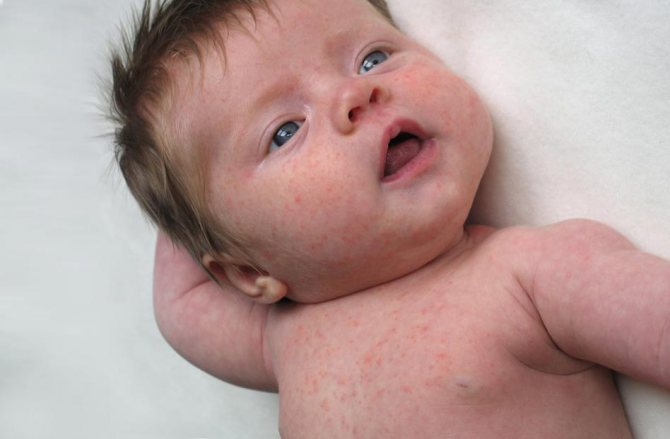
A viral disease caused by the human herpes virus, the disease affects children aged 6 months to 3 years. More details about the disease and photos of rubella in children.
Symptoms and signs include high body temperature, rash on the torso, neck and face, mood swings and seizures. Seizures, although very rare in children, are a very serious complication of this disease. They lead to jerking of the body and even loss of consciousness in severe cases.
Prevention includes vaccination, as this is the only known preventive measure that stimulates the immune system in children with the possibility of rubella.
Treatment is accompanied by confirmed clinical signs of this disease. Because this disease is caused by a virus, the body's immune system will fight the infection on its own; at the same time, symptomatic treatment can be given for rash and high fever. A doctor should be called immediately when a child has seizures or if the temperature persists .
